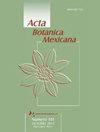番荔枝叶提取物与果肉复合饮料的配方及植物化学分析
IF 0.8
4区 生物学
Q4 PLANT SCIENCES
引用次数: 0
摘要
背景与目的:凤仙花饮料在传统医学中被广泛用于治疗各种疾病;然而,它们几乎没有植物化学特征,而且作为含糖饮料饮用,可能导致非传染性疾病,包括肥胖。这项工作的目的是获得和表征一种感官上可接受的饮料,从提取的muricata叶和果肉。方法:采用混合设计法,以不同比例的水提物与木香浆混合配制9种饮料。对这些饮料进行了理化和感官评价。根据这些结果,选择了一种饮料,用分光光度法进行表征,并与冲泡饮料和商业饮料进行了比较。此外,通过超高效色谱-质谱联用和高效液相色谱-光电二极管阵列检测器联用进一步分析所选饮料的植物化学成分。关键结果:所选饮料的配方为:25%纸浆、50%叶提取物、25%水;白锐度为7.63°,pH为3.42,酸度为0.40%。这种饮料的生物活性化合物含量是灌注饮料和商业饮料的三倍。初步鉴定出14种酚类化合物和2种醋酸原,并鉴定出2种生物碱和15种醋酸原。结论:木香叶提取物和木香果肉的结合是获得一种感官上可接受的饮料的重要替代方法,这种饮料含有具有潜在药用作用的生物活性化合物,因为饮料中的酚类化合物、生物碱和乙酰原素具有有效的生物活性,可以预防慢性退行性疾病。本文章由计算机程序翻译,如有差异,请以英文原文为准。
Formulation and phytochemical analysis of a potentially functional beverage from combining a leaf extract and pulp of Annona muricata (Annonaceae)
Background and Aims: Annona muricata beverages are widely used in traditional medicine to treat different ailments; however, they have been little characterized phytochemically and are consumed as sugary beverages, and may contribute to non-communicable diseases, including obesity. The objective of this work was to obtain and characterize a sensorially acceptable beverage from an extract of A. muricata leaves and pulp.
Methods: A mixture design was used to formulate nine beverages by combining different ratios of the aqueous extract of A. muricata leaves and pulp. These beverages were subjected to physicochemical and sensory evaluation. Based on these results, one beverage was selected to be characterized by spectrophotometry and compared with an infused and commercial beverage. In addition, the selected beverage was further analyzed for its phytochemical composition by ultra-high-performance chromatography coupled to mass spectrometry and high-performance liquid chromatography coupled to a photodiode array detector.
Key results: The selected beverage was formulated with 25% pulp, 50% leaf extract, and 25% water; it also displayed a 7.63 °Brix, pH 3.42, and 0.40% acidity. This beverage was up to three times higher in bioactive compounds than infused and commercial beverages. Fourteen phenolic compounds and two acetogenins were quantified, while two alkaloids (coclaurine and reticuline) and fifteen acetogenins were tentatively identified.
Conclusions: The combination of A. muricata leaf extract and pulp is a vital alternative to obtain a sensorially acceptable beverage that contains bioactive compounds with a potential medicinal action since the phenolic compounds, alkaloids, and acetogenins present in the beverage could have efficient biological activities in the prevention of chronic degenerative diseases.
求助全文
通过发布文献求助,成功后即可免费获取论文全文。
去求助
来源期刊

Acta Botanica Mexicana
生物-植物科学
CiteScore
1.60
自引率
12.50%
发文量
52
审稿时长
>12 weeks
期刊介绍:
Acta Botanica Mexicana da a conocer trabajos originales e inéditos en todas las áreas de la botánica, incluyendo florística, taxonomía, taxones nuevos para la ciencia, ecología, etnobotánica, paleontología, evolución, conservación, etc. Está dirigida a botánicos mexicanos y extranjeros que aporten información en estas áreas del conocimiento, particularmente con plantas nativas del continente americano. Hasta 2018 apareció cuatro veces al año con una periodicidad estricta en la primera semana de enero, abril, julio y octubre; a partir de 2019 se publica de manera continua, sin periodicidad preestablecida, en formato electrónico y de forma gratuita.
 求助内容:
求助内容: 应助结果提醒方式:
应助结果提醒方式:


